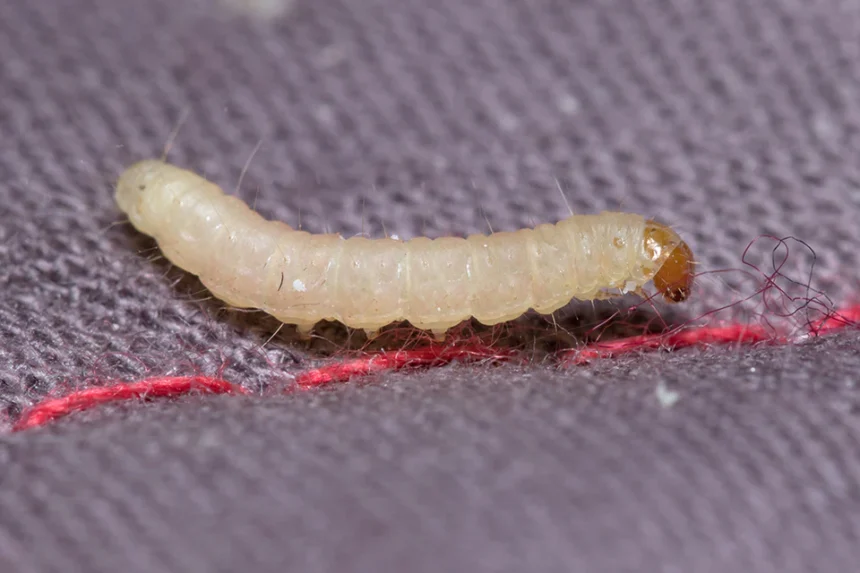Introduction
Many homeowners in the United States encounter small worm-like creatures in their kitchens, food storage areas, or garbage bins. At first glance, these pests may look the same, but they can belong to very different insect groups. One common source of confusion is between moth larvae and maggots. Both are tiny, pale, and wriggling, but their origins, habits, and risks differ. In this article, we’ll explore moth larvae vs maggots, how to tell them apart, and safe ways to handle them.
What Are Moth Larvae?
Moth larvae are the caterpillar stage of moths. When moth eggs hatch, they release larvae that feed until they are ready to spin cocoons and transform into adult moths.
- Common household types:
- Pantry moth larvae (Indian meal moth, Mediterranean flour moth)
- Clothes moth larvae (case-bearing clothes moth, webbing clothes moth)
- Appearance: Usually white or cream, sometimes with a brown head, about ½ inch long.
- Where they appear:
- Dry food items like rice, flour, grains, cereals, nuts, or pet food.
- Wardrobes and storage areas, where larvae chew through natural fabrics like wool, silk, or fur.
Moth larvae are not naturally harmful to humans, but they contaminate food supplies and damage clothing if left unchecked.
What Are Maggots?
Maggots are the larval stage of flies, particularly houseflies and blowflies. Flies lay eggs in moist, decaying organic matter, which hatch into maggots.
- Appearance: Legless, cream to white, soft-bodied worms that often wriggle actively. They are more translucent and slimy compared to moth larvae.
- Where they appear:
- Garbage bins, spoiled food, compost, and sometimes dead animals.
- Areas with poor waste management or sanitation.
Unlike moth larvae, maggots grow quickly, and their presence usually signals unhygienic conditions or decaying matter.
Moth Larvae vs Maggots: Main Differences
Feature Moth Larvae (Caterpillars) Maggots (Fly Larvae)
Origin: Hatch from moth eggs, Hatch from fly eggs
Appearance: Whitish with a visible head, may spin silk. Slimy, legless, headless, translucent.
Habitat: Dry food, grains, clothes, cupboards. Garbage, rotting food, compost
Damage contaminates food, ruins fabrics, indicates decay, and spreads bacteria.
Lifecycle Weeks to months before pupation. Only a few days before pupation
This comparison shows why people often confuse the two; both are worm-like and small, but their behaviour and sources are very different.
Why Do People Confuse Them?
Both moth larvae and maggots are pale, wriggling, and unwelcome in homes. In a poorly lit pantry or trash bin, it’s easy to mistake one for the other. However, moth larvae are linked to stored foods and fabrics, while maggots are strongly linked to waste and decay. Knowing the difference is important because it affects how you remove and prevent them.
Risks and Concerns
- Moth larvae: They contaminate food by leaving silk, droppings, or shed skin in pantry items. Eating infested food accidentally is unpleasant but not usually harmful. Clothes moth larvae, on the other hand, damage natural fibres and can ruin expensive garments.
- Maggots: Their presence indicates decaying food or organic waste. While maggots themselves are not poisonous, they can spread bacteria like E. coli or Salmonella from the material they feed on. Proper hygiene is essential.
⚠️ Note: This article is for educational purposes only and does not provide medical advice. If you experience allergic reactions, infections, or health concerns, consult a medical professional.
How to Identify Them Quickly
- Signs of moth larvae:
- Webbing or clumps in flour and cereals
- Tiny holes in stored clothes
- Small cocoons in cupboards or closets
- Signs of maggots:
- Clusters of wriggling worms in Garbage or spoiled food
- Unpleasant odours from waste
- Presence of adult flies nearby
Safe Removal and Prevention
For moth larvae:
- Inspect and discard infested food items.
- Clean cupboards with hot, soapy water or vinegar.
- Store dry foods in airtight containers.
- Wash or freeze affected clothing to kill larvae and eggs.
For maggots:
- Remove trash and sanitise bins regularly.
- Clean with boiling water or disinfectants.
- Prevent flies by sealing waste and covering food.
- Use fly screens or traps if infestation is recurring.
Both issues can often be handled at home, but heavy infestations may require professional pest control.
Competitor & Authority Insights
Several US pest-control services and information sources address this confusion:
- Orkin (major pest control provider) has detailed guides on pantry moths and fly infestations.
- Terminix explains prevention methods.





